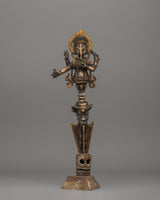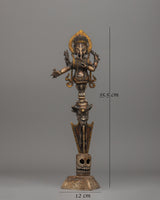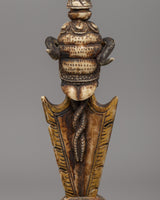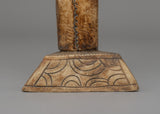









Handcrafted Ganesh Phurba | Powerful Ritual Tool for Protection & Spiritual Growth
Ganesh Phurba with Makara and Wrathful Deity
--------------------------------------------
Size: 35.5 cm(Height) x 12 cm(Width)
Weight: 0.35 kg
Material: Ethically Sourced Buffalo Bone
--------------------------------------------
About The Ritual Item :
This 35.5cm tall and 12cm wide Ganesh Phurba is expertly Sourced from ethically obtained buffalo bone, a material valued for its spiritual significance and sustainability in Buddhist rituals. The Ganesh Phurba's height and detailed embellishments make it an effective tool for rituals and spiritual protection, and it is ideal for use in meditation, offerings, and holy locations. This ritual dagger is more than just a spiritual instrument; it is also a wonderfully carved object that contains the divine force of Lord Ganesh, the remover of barriers, and provides both protection and spiritual empowerment.
The symbolism of this Ganesh Phurba depicts Lord Ganesha standing atop the Phurba, representing the removal of barriers and the purging of negative energy. The Makara in the center protects against spiritual perils and signifies the balance of water and land, giving purification. At its core, the wrathful deity represents the force that removes ignorance and spiritual delusion, resulting in spiritual development and empowerment. The Phurba, a Buddhist symbol of spiritual development, helps dispel illusions and establish a clear path to enlightenment. This sacred object is an excellent addition to any ritual setting, providing spiritual strength, protection, and the ability to convert negative into positive energy.
Introduction To The Phurba :
The ceremonial dagger (Sanskrit: Kila; Tibetan: phurba) is important for expelling evil and is considered especially effective in neutralizing the forces that obstruct Tantric Buddhist practice. It has ancient origins, first appearing in the Indian Rg Veda as the core blade of the vajra used by Indra to destroy the primordial cosmic snake Vritra. Kila, a peg or stake in Sanskrit, was most likely associated with Vedic sacrifices. Meditation on the Vajrakila Tantra, an early Indian scripture first promoted in Tibet in the eighth century by Padmasambhava, one of the founding teachers of Tibetan Buddhism, is used to invoke the three-headed Vajrakila Buddha.
How to set up your own Buddhist Shrine?
Find a clean, quiet, and uncluttered spot
Set up an altar table, and cover it with an altar cloth that calls to you
Place your sacred item (statue, thangka, or a picture of Buddha) at the center
















